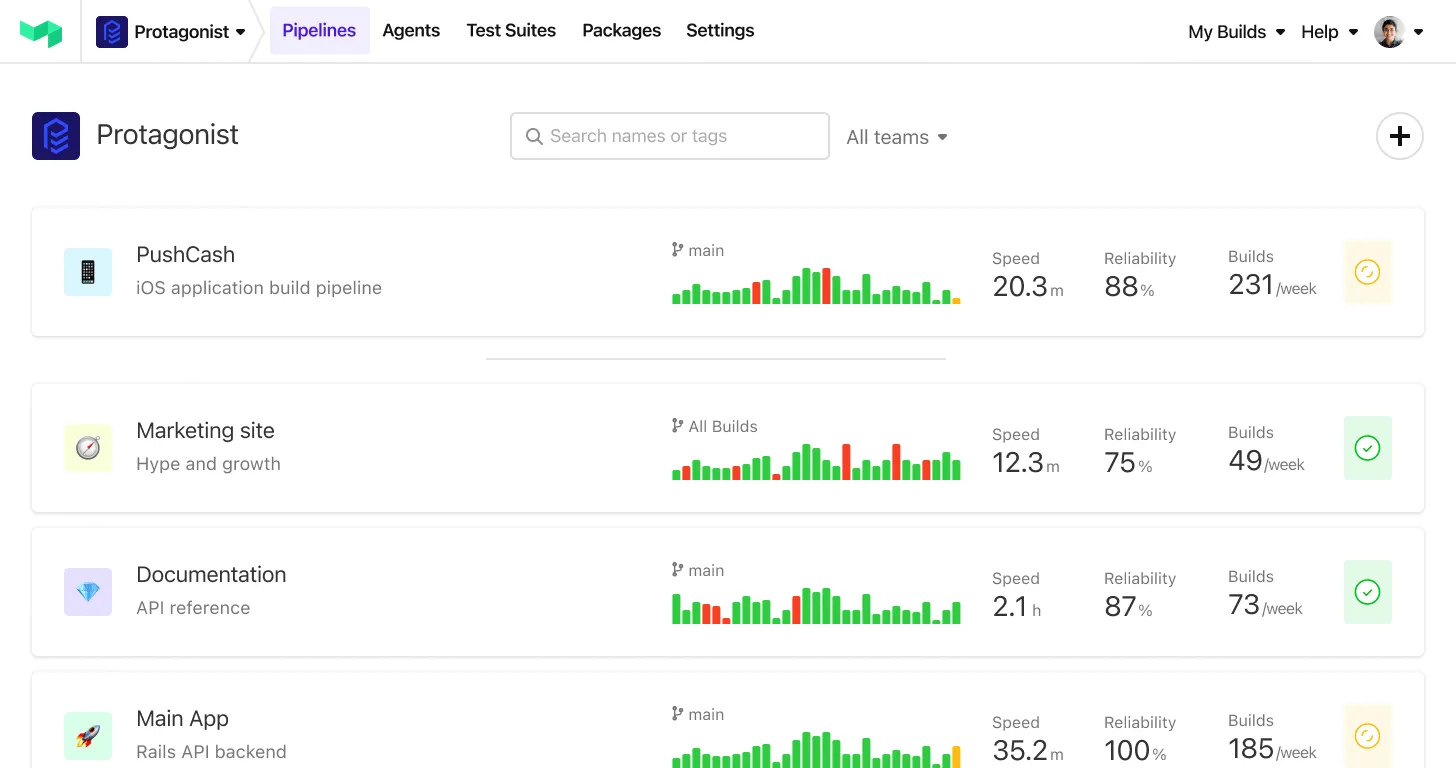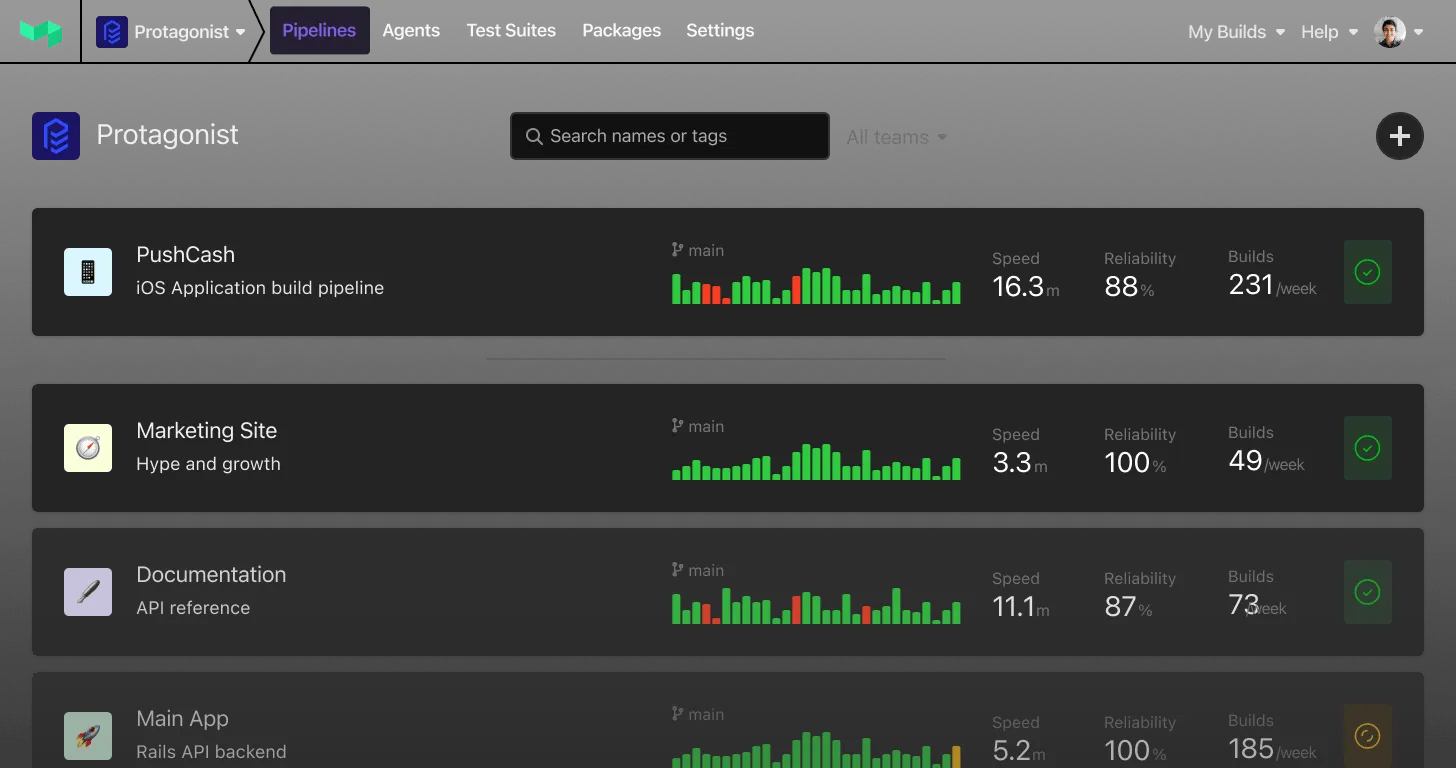build-and-push-buildkite-plugin
A concise plugin to assist with build multi-arch container images and pushing them to an ECR repository.
Subsequent pipeline steps can depend_on the step key: build-and-push to ensure that image building and pushing is complete before continuing (see group-key for configuring this value).
Usage
steps:
- plugins:
- CatchoftheDay/build-and-push#v1.6.2:
push-branches: testing,main,masterConfiguration
All configuration is optional.
steps:
- plugins:
- CatchoftheDay/build-and-push#v1.6.2:
dockerfile-path: app/Dockerfile
context-path: "."
image-name: my-super-special-application
image-tag: latest
mutate-image-tag: true
repository-namespace: wes-digital
additional-tag: $BUILDKITE_BUILD_NUMBER
build-args: "secret-from-vault,not-a-secret=42"
push-branches: testing,main,master
build-arm: true
build-x86: true
scan-image: true
group-key: build-and-push-0.0.1
always-pull: false
additional-plugins: []dockerfile-path [string]
The relative path of the Dockerfile from the project root. Default: Dockerfile
context-path [string]
The path used as the root of the docker build environment. This effects the source location and availablility of files referenced with ADD in the Dockerfile. Default: . (the project root)
repository-namespace [string]
The namespace of the ECR repository to push to. Default: catch
image-name [string]
The name of your application image. Will be prefixed with catch/ before being pushed to the registry. Default: Buildkite pipeline name ($BUILDKITE_PIPELINE_NAME).
image-tag [string]
A container image tag. Default: First 10 characters of git SHA.
additional-tag [string]
An additional tag for the image, useful if the main tag is dynamic or vis-versa. Default: None
mutate-image-tag [boolean]
Enable an existing tag to be over-written when pushing this image to ECR. WARNING: This will overwrite a tag even if the repository has immutable tags enabled. Default: false
build-args [comma-delimited list]
Additional build-arguments (--build-arg) to pass to docker build. These can be single values (ideally used for secrets that are available to every pipeline step as env vars) or key=value pairs which can be used to pass in non-secret values that aren’t known to every step of the pipeline. Default: ""; GITHUB_TOKEN, BUILDKITE_COMMIT, BUILDKITE_JOB_ID and BUILD_DATE (unit timestamp) are always provided.
push-branches [comma-delimited list]
A list of branch names for which to push a built image to ECR. This can serve as a toggle to be able to test container builds in feature branches but only push those images to ECR for deployable branches. If the build is triggered from a non-branch event (such as a git tag) it will always be pushed to ECR. Default: ""
build-arm [boolean]
Should we build an ARM image? Default: true
build-x86 [boolean]
Should we build an x86 image? Default: true
scan-image [boolean]
Should the container image be scanned the security scanner? This step is non-blocking (but this may change in the future). Default: true
group-key [string]
This is the key assigned to the job group that encapsulates the build tasks. This key is used by subsequent jobs that depend this build completing. Default: build-and-push
always-pull [boolean]
Should the builder always attempt to pull fresh source images. This will ensure it always uses the latest available version of an image tag. Can be disabled to potentially improve build times slightly if there is low risk of the upstream tagged image being updated. Default: true
additional-plugins [array]
Pass through additional plugins to this plugin’s steps, useful in cases where you may need to login to an image registry.
- label: ":docker: Build and upload container to ECR"
plugins:
- CatchoftheDay/build-and-push#v1.6.2:
additional-plugins:
- docker-login#v3.0.0:
server: your-image-registry.io
username: your_username
password-env: your_password-envcomposer-cache [boolean]
Attempt to utilize a buildkite-cached composer package cache (not a cache of vendor) when building the image. The cache must be available at .composer-cache. The cache will be made available as a build context called composer-cache (see utilising-package-caches for how to take advantag of this in your builds). If the image builds successfully the cache will be resaved at pipeline level so it can be reused as a base even if the manifest changes. See the buildkite cache plugin for further details of how this works. Default: false
example
- label: cache-composer-deps
command: |
composer config -g github-oauth.github.com $${GITHUB_TOKEN};
composer config -g cache-dir ./.composer-cache;
composer install --download-only;
plugins:
- docker#v5.6.0:
image: "362995399210.dkr.ecr.ap-southeast-2.amazonaws.com/catch/php-base:8.1-fpm-buster"
always-pull: true
mount-ssh-agent: true
propagate-environment: true
environment:
- GITHUB_TOKEN
- cache#v0.6.0:
backend: s3
manifest: composer.lock
path: .composer-cache
save: file
restore: pipeline
- label: ":docker: Build and upload container to ECR"
plugins:
- CatchoftheDay/build-and-push#v1.6.2:
composer-cache: true
push-branches: testing,main,masternpm-cache [boolean]
Attempt to utilize a buildkite-cached npm package cache (not a cache of node_modules) when building the image. The cache must be available at .npm-cache. The cache will be made available as a build-context called npm-cache (see utilising-package-caches for how to take advantag of this in your builds). If the image builds successfully the cache will be resaved at pipeline level so it can be reused as a base even if the manifest changes. See the buildkite cache plugin for further details of how this works. Default: false
example
- label: cache-node-deps
command: |
echo "//npm.pkg.github.com/:_authToken=$${GITHUB_TOKEN}" > ~/.npmrc;
npm config set -g cache ./.npm-cache;
npm ci;
plugins:
- docker#v5.6.0:
image: "362995399210.dkr.ecr.ap-southeast-2.amazonaws.com/catch/node-base:18-buster-slim"
always-pull: true
mount-ssh-agent: true
propagate-environment: true
environment:
- GITHUB_TOKEN
- cache#v0.6.0:
backend: s3
manifest: package-lock.json
path: .npm-cache
save: file
restore: pipeline
- label: ":docker: Build and upload container to ECR"
plugins:
- CatchoftheDay/build-and-push#v1.6.2:
npm-cache: true
push-branches: testing,main,masteryarn-cache [boolean]
Attempt to utilize a buildkite-cached npm package cache (not a cache of node_modules) when building the image. The cache must be available at .yarn-cache. The cache will be made available as a build-context called yarn-cache (see utilising-package-caches for how to take advantag of this in your builds). If the image builds successfully the cache will be resaved at pipeline level so it can be reused as a base even if the manifest changes. See the buildkite cache plugin for further details of how this works. Default: false
example
- label: cache-node-deps
command: |
echo "//npm.pkg.github.com/:_authToken=$${GITHUB_TOKEN}" > ~/.npmrc;
yarn config set cache-folder ./.yarn-cache;
yarn install --frozen-lockfile;
plugins:
- docker#v5.6.0:
image: "362995399210.dkr.ecr.ap-southeast-2.amazonaws.com/catch/node-base:18-buster-slim"
always-pull: true
mount-ssh-agent: true
propagate-environment: true
environment:
- GITHUB_TOKEN
- cache#v0.6.0:
backend: s3
manifest: yarn.lock
path: .yarn-cache
save: file
restore: pipeline
- label: ":docker: Build and upload container to ECR"
plugins:
- CatchoftheDay/build-and-push#v1.6.2:
yarn-cache: true
push-branches: testing,main,masterUtilising package caches
Only including the composer-cache: true or npm-cache: true or yarn-cache: true flags isn’t sufficient to take advantage of your package cache. The projects Dockerfile will also need to contain something like the following when performing the install step with the package manager.
composer
RUN --mount=type=cache,from=composer-cache,target=/root/.cache/composer \
set -ex && \
composer install \
--no-scripts \
--no-progress \
--no-suggest \
--prefer-dist \
--no-dev \
--no-autoloader \
--no-interactionnpm
RUN --mount=type=cache,from=npm-cache,target=/root/.npm \
set -ex && \
npm ciyarn
RUN --mount=type=cache,from=yarn-cache,target=/root/.npm \
set -ex && \
yarn config set cache-folder /root/.npm && \
yarn install --frozen-lockfileThis will ensure that package files are picked up from the cache rather than being redownloaded from the internet.

